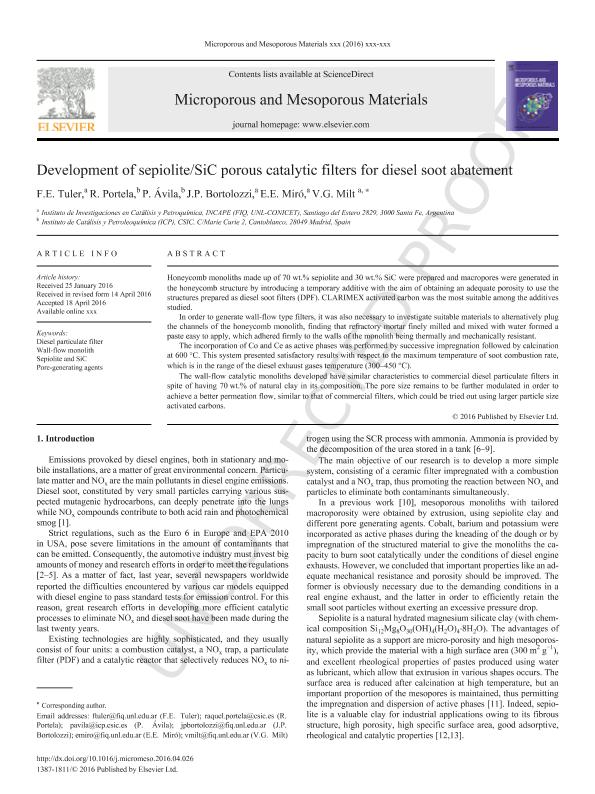Artículo
Development of sepiolite/SiC porous catalytic filters for diesel soot abatement
Tuler, Fernando Esteban ; Portela, R.; Ávila, P.; Bortolozzi, Juan Pablo
; Portela, R.; Ávila, P.; Bortolozzi, Juan Pablo ; Miro, Eduardo Ernesto
; Miro, Eduardo Ernesto ; Milt, Viviana Guadalupe
; Milt, Viviana Guadalupe
 ; Portela, R.; Ávila, P.; Bortolozzi, Juan Pablo
; Portela, R.; Ávila, P.; Bortolozzi, Juan Pablo ; Miro, Eduardo Ernesto
; Miro, Eduardo Ernesto ; Milt, Viviana Guadalupe
; Milt, Viviana Guadalupe
Fecha de publicación:
08/2016
Editorial:
Elsevier Science
Revista:
Microporous and Mesoporous Materials
ISSN:
1387-1811
Idioma:
Inglés
Tipo de recurso:
Artículo publicado
Clasificación temática:
Resumen
Honeycomb monoliths made up of 70 wt.% sepiolite and 30 wt.% SiC were prepared and macropores were generated in the honeycomb structure by introducing a temporary additive with the aim of obtaining an adequate porosity to use the structures prepared as diesel soot filters (DPF). CLARIMEX activated carbon was the most suitable among the additives studied. In order to generate wall-flow type filters, it was also necessary to investigate suitable materials to alternatively plug the channels of the honeycomb monolith, finding that refractory mortar finely milled and mixed with water formed a paste easy to apply, which adhered firmly to the walls of the monolith being thermally and mechanically resistant. The incorporation of Co and Ce as active phases was performed by successive impregnation followed by calcination at 600°C. This system presented satisfactory results with respect to the maximum temperature of soot combustion rate, which is in the range of the diesel exhaust gases temperature (300-450°C). The wall-flow catalytic monoliths developed have similar characteristics to commercial diesel particulate filters in spite of having 70 wt.% of natural clay in its composition. The pore size remains to be further modulated in order to achieve a better permeation flow, similar to that of commercial filters, which could be tried out using larger particle size activated carbons.
Archivos asociados
Licencia
Identificadores
Colecciones
Articulos(INCAPE)
Articulos de INST.DE INVEST.EN CATALISIS Y PETROQUIMICA "ING. JOSE MIGUEL PARERA"
Articulos de INST.DE INVEST.EN CATALISIS Y PETROQUIMICA "ING. JOSE MIGUEL PARERA"
Citación
Tuler, Fernando Esteban; Portela, R.; Ávila, P.; Bortolozzi, Juan Pablo; Miro, Eduardo Ernesto; et al.; Development of sepiolite/SiC porous catalytic filters for diesel soot abatement; Elsevier Science; Microporous and Mesoporous Materials; 230; 8-2016; 11-19
Compartir
Altmétricas



